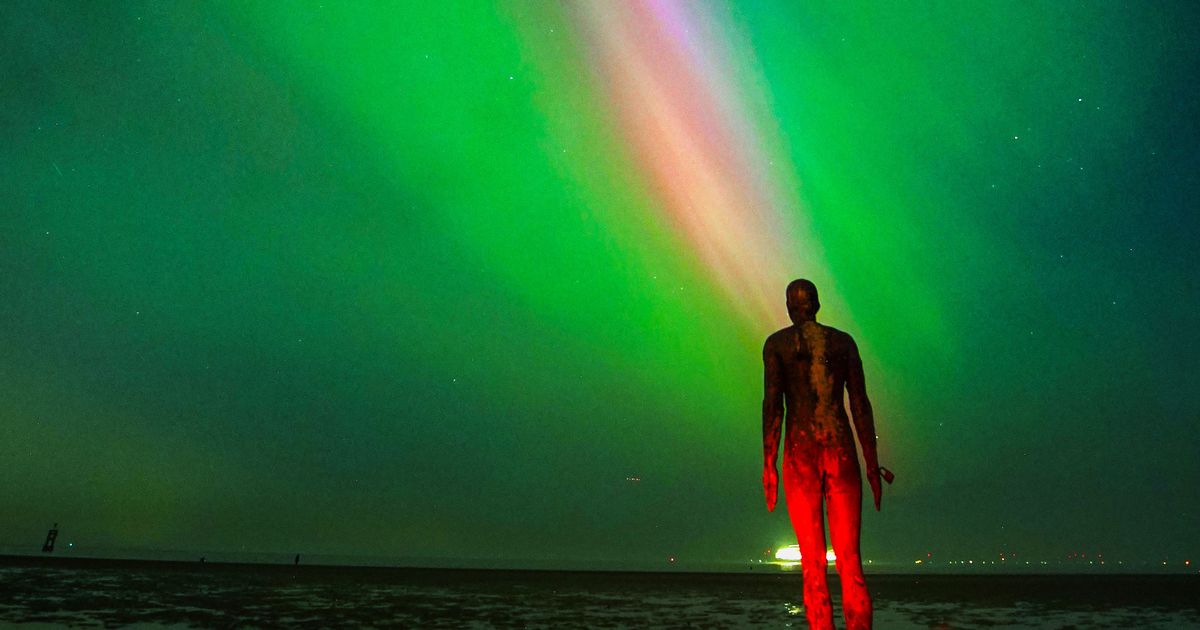The aurora borealis can be a beautiful sight if the sky is clear enough The aurora borealis over Crosby Beach, Liverpool(Image: PA)
The aurora borealis over Crosby Beach, Liverpool(Image: PA)
A glimpse of the Northern Lights may be possible for parts of the UK this evening and tomorrow, October 13. The Met Office’s Space Weather agency has shared a promising update for anyone living in northern areas of England, particularly Scotland.
The aurora forecast for those living in the northern hemisphere states: “Where cloud breaks allow, Northern Scotland may see some enhancement to the auroral oval Sunday evening and into Monday due to a connection to a fast wind. This connection is expected to wane through Sunday and into the start of the working week, becoming increasingly unlikely to see the aurora.”
The northern lights are colourful, dynamic, and visually delicate displays of particles and magnetism between the Sun and Earth called space weather. When energetic particles from space collide with atoms and molecules in the atmosphere, they can cause the colourful glow that we call auroras.
The Sun continuously produces an outflow of charged particles into the solar system known as the solar wind. When the solar wind reaches Earth, it can interact with Earth’s magnetic shield, often depositing and accumulating energy there. When this energy is finally released, much of it rains down on our atmosphere, causing auroras.
According to NASA: “An aurora can appear in a variety of colours, from an eerie green to blue and purple to pink and red. When particles from space bombard gases in the atmosphere, they can give the atoms and molecules of the gases extra energy that’s released as tiny specks of light. The colour of an aurora depends on the type of gas that is hit and where that gas is located in the atmosphere.”
In the Met Office’s four-day solar activity forecast, it indicates low activity is likely to continue with a slight chance of rising to Moderate with any isolated Moderate-class flares.
A Met Office map below shows the UK at 9pm this evening, October 12. The red indicates a 90% chance of the Northern Lights being visible.
 Met Office weather map shows parts of northern England with 90% chance of seeing northern lights this evening (9pm pictured above)(Image: Met Office)
Met Office weather map shows parts of northern England with 90% chance of seeing northern lights this evening (9pm pictured above)(Image: Met Office)
New or returning regions are expected to rotate onto the disc from late day 1 and into day 2 (12-13 Oct) and along with the current developing Earth facing regions, this may bring an increase in probabilities of significant flares.
Further insight into the potential glimpse of the Northern Lights this evening from the Met Office, states: “There are currently seven active regions on the Earth-facing disc. Of the two largest, and most magnetically complex regions, one is in the northern centre disc and the other in the northeast.
“Both have shown some slight development in their intermediate spots and display mixed polarity spots. The rest of the sunspots are small and magnetically simple.
“No Earth-directed Coronal Mass Ejections (CMEs) have been identified in recent imagery. However a large prominence eruption occurred around 12/0900 UTC from the south, most likely on the farside. This was shortly followed by a second CME from the northeast, most likely going behind Earths orbit. We await further analysis on these events.”
A coronal mass ejection (CME) is an enormous cloud of electrically charged gas, called plasma, that erupts from the Sun. A single coronal mass ejection can blast billions of tons of material into the solar system all at once.
CMEs occur in the outer atmosphere of the Sun, called the corona, and often look like giant bubbles bursting from the Sun. When it hits Earth, it can cause Northern Light displays as charged particles interact with atoms and molecules in Earth’s atmosphere.
CMEs can wreak havoc with power grids, telecommunication networks and orbiting satellites and expose astronauts to dangerous doses of radiation. The biggest flares are known as “X-class flares” based on a classification system that divides solar flares according to their strength. The smallest ones are A-class
Remote, open areas with views of the northern horizon are best for sightings, with the lights unlikely to be visible until it gets very dark. The Sun is currently at the peak of its 11-year activity cycle, known as its solar maximum period. This is a result of the star’s magnetic poles flipping, which causes it to transition to an active and stormy state
The most active region on the Sun is currently rotating to face Earth, leading to forecasts of more significant space weather. NASA observes the sun and our space environment constantly with a fleet of spacecraft that study everything from the sun’s activity to the solar atmosphere and the particles and magnetic fields in the space surrounding Earth.

